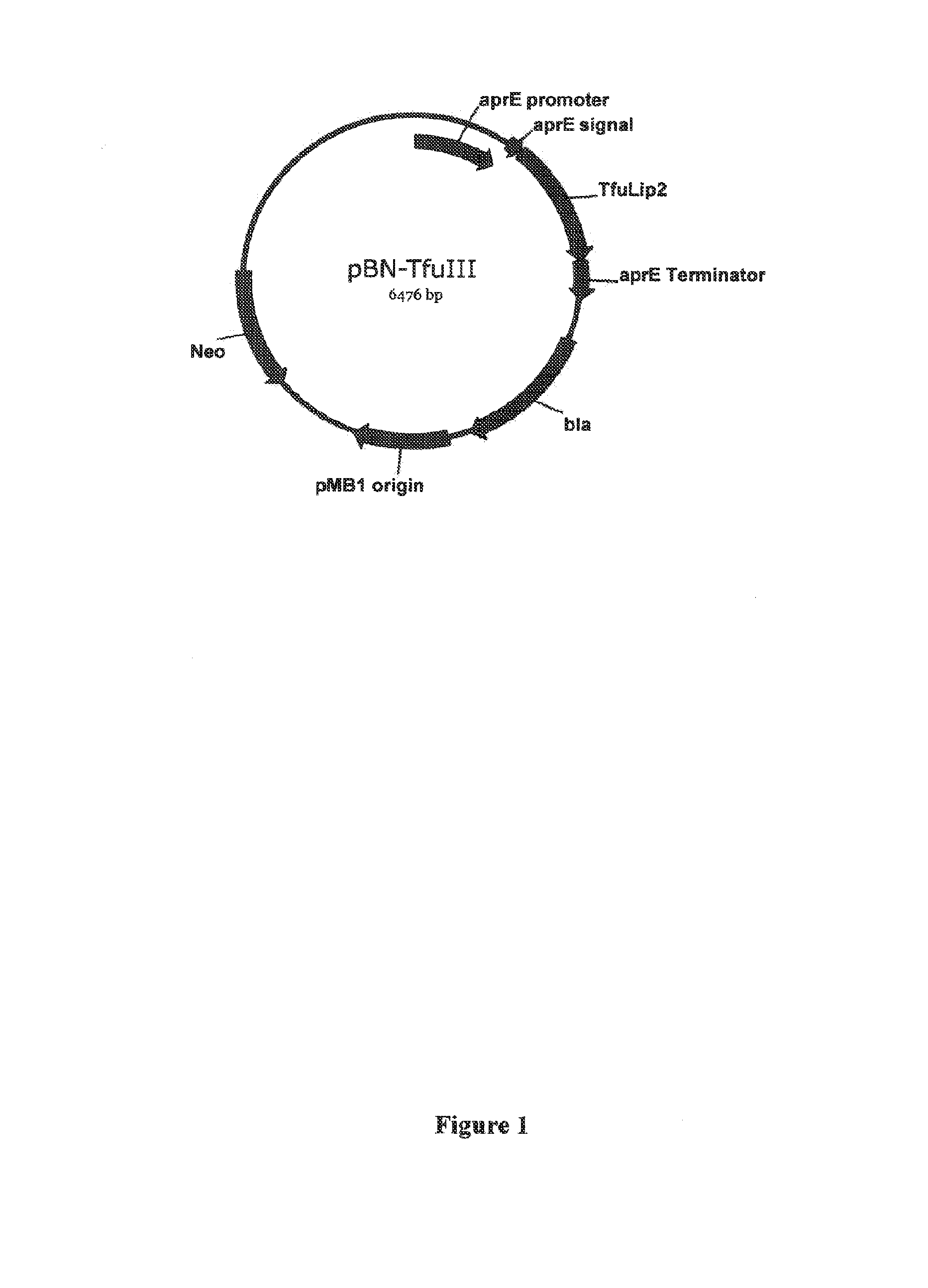Compositions and Methods Comprising a Lipolytic Enzyme Variant
a technology of lipolytic enzyme and variant, which is applied in the direction of detergent composition, enzymology, detergent compounding agents, etc., can solve the problems of inhibiting enzymes, and achieve the effects of improving the efficiency of enzymes in wash cycles, and enhancing the efficiency of enzymes
- Summary
- Abstract
- Description
- Claims
- Application Information
AI Technical Summary
Benefits of technology
Problems solved by technology
Method used
Image
Examples
example 1
Assays
[0270]The following assays are standard assays used in the examples described below. Occasionally specific protocols call for deviations from these standard assays. In those cases, deviations from these standard assay protocols below are identified in the examples.
[0271]The performance index (PI) compares the performance of the variant (measured value) and the standard enzyme (theoretical value) at the same protein concentration. In addition, the theoretical values can be calculated, using the parameters of the Langmuir equation of the standard enzyme.
[0272]A performance index (PI) that is greater than 1 (PI>1) indicates improved performance by a variant as compared to the standard (e.g., TfuLip2), while a PI of 1 (PI=1) identifies a variant that performs the same as the standard, and a PI that is less than 1 (PI<1) identifies a variant that performs worse than the standard.
B. Hydrolysis of p-Nitrophenyl Esters
[0273]The TfuLip2 variants are assayed for lipa...
example 2
Generation of Thermobifida fusca Lipase2 (TfuLip2) Site Evaluation Libraries (“SELs”)
[0296]The Thermobifida fusca lipase 2 (or BTA-hydrolase 2) gene was previously identified (Lykidis et al., J. Bacteriol, (2007) 189:2477-2486), with the sequence set forth as GENBANK Accession No. YP—288944.
[0297]The Thermobifida fusca lipase 2 (TfuLip2) gene was synthesized at BaseClear BV (Leiden, The Netherlands) and they cloned into their standard E. coli vector. The TfuLip2 gene was then sub-cloned into the pBN based Bacillus expression vector already containing the aprE promoter and aprE signal sequence (Babe' et al. (1998), Biotechnol. Appl. Biochem. 27: 117-124). Ligation of this vector to the synthetic gene encoding a TfuLip2 enzyme resulted in the fusion of the N-terminus of the TfuLip2 polypeptide to the third amino acid of the Bacillus subtilis AprE pro-peptide encoded by the expression vector. Following the natural signal peptidase cleavage in the host, the recombinant TfuLip2 protein p...
example 3
Productive Positions and Combinable Mutations
[0305]Productive positions are described as those positions within a molecule that are most useful for making combinatorial variants exhibiting an improved characteristic, where the position itself allows for at least one combinable mutation. Combinable mutations can be described as those substitutions in a molecule that can be used to make combinatorial variants. Combinable mutations are ones that improve at least one desired property of the molecule, while not significantly decreasing either: expression, activity, or stability.
[0306]Combinable mutations are ones that improve at least one desired property of the molecule, while not significantly decreasing either: expression, activity, or stability. Combinable mutations in Tfulip2 were determined using performance index (PI) values resulting from the assays described in Example 1: CS-61 micro-swatch assay, hydrolysis of p-Nitrophenyl esters, detergent stability and thermostability assays...
PUM
| Property | Measurement | Unit |
|---|---|---|
| pH | aaaaa | aaaaa |
| pH | aaaaa | aaaaa |
| wt % | aaaaa | aaaaa |
Abstract
Description
Claims
Application Information
 Login to View More
Login to View More - R&D
- Intellectual Property
- Life Sciences
- Materials
- Tech Scout
- Unparalleled Data Quality
- Higher Quality Content
- 60% Fewer Hallucinations
Browse by: Latest US Patents, China's latest patents, Technical Efficacy Thesaurus, Application Domain, Technology Topic, Popular Technical Reports.
© 2025 PatSnap. All rights reserved.Legal|Privacy policy|Modern Slavery Act Transparency Statement|Sitemap|About US| Contact US: help@patsnap.com



